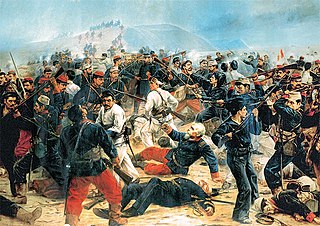 W
WThe Battle of Arica, also known as Assault and Capture of Cape Arica, was a battle in the War of the Pacific. It was fought on 7 June 1880, between the forces of Chile and Peru.
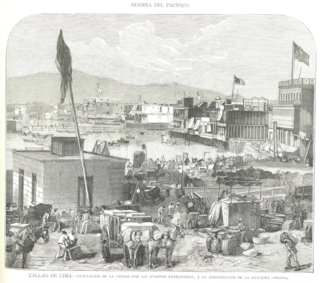 W
WThe Blockade of Callao was a military operation that occurred during the War of the Pacific or the Salitre War and that consisted of the Chilean squadron preventing the entry of ships to the port of Callao and the neighboring coves between 10 April 1880 and 17 January 1881.
 W
WThe Battle of Cancha Rayada, was fought in Chile between South American patriots and Spanish royalists, during the Osorio's campaign in the South American wars of independence. The result was a defeat for the patriot forces, weeks later the patriots take their rematch at the Battle of Maipú.
 W
WThe Battle of Chacabuco, fought during the Chilean War of Independence, occurred on February 12, 1817. The Army of the Andes of the United Provinces of the Río de la Plata led by General Captain José de San Martín defeated the Spanish force led by Rafael Maroto. It was a defeat for the Captaincy General of Chile, the royalist government established after the division of the Viceroyalty of Peru.
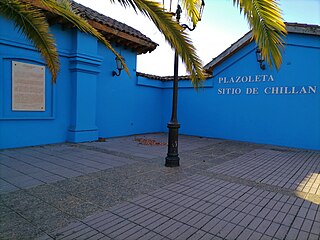 W
WThe Siege of Chillán occurred July 27 to August 10, 1813, as patriot forces attempted to dislodge a determined band of royalist defenders. The failure of José Miguel Carrera to take the city would contribute to his removal from office by the junta later in the campaign.
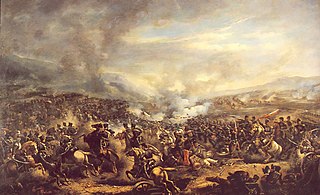 W
WThe Battle of El Roble was fought on the Itata river, 17 October 1813, between the Chilean patriot general José Miguel Carrera and Spanish royalist forces under the command of Clemente Lantaño and de Luis Urrejola. The surprise patriot victory at El Roble as a result of Bernardo O'Higgins' actions at the end of the day was to result in a change of patriot commander, and a severe split within the patriot movement.
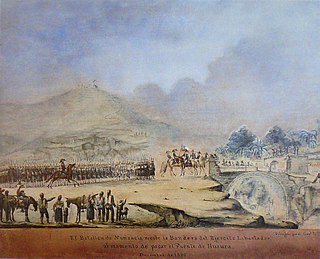 W
WThe Expedición Libertadora del Perú was a force organized in 1820 by Chilean government, with elements belonging to the Liberating Army of the Andes and to recently restored Army of Chile. On 5 February 1819, a treaty was signed between Chile and the United Provinces to finance and organize the expedition to Peru, but in fact, it is Chile who made the effort to do it, since the United Provinces are distracted by internal conflicts and the direct threat of invasion from Spain. The expedition was the continuation of the plan of liberation that General José de San Martín conceived for the Spanish colonies in the Pacific of South America, with the support of General Bernardo O'Higgins in Chile. While the Chilean government headed by Bernardo O'Higgins played a pivotal role in organizing the expedition, the control of the Chilean Squadron was given to the British sailor Thomas Cochrane and the control of the Army was given to the Argentine General José de San Martín. The expedition liberated parts of Peru from Spanish Crown control. The complete liberation of Peru was achieved in 1824 with the intervention of Simón Bolívar.
 W
WThe Battle of Huamachuco was fought on the 10 July 1883, and it was the last major battle of the War of the Pacific. The Chilean soldiers led by Colonel Alejandro Gorostiaga decisively defeated the Peruvian army commanded by General Andrés Avelino Cáceres near the town of Huamachuco. This Chilean victory effectively eliminated Cáceres' Ejército de la Breña, ending any real threat or resistance in the Peruvian Andes. The Peruvian defeat paved the way for the Treaty of Ancon that finally put an end to the war. Also, one of Peru's greatest heroes, Colonel Leoncio Prado, died as a consequence of this battle.
 W
WThe Battle of Concepción was a battle fought between Chilean and Peruvian forces on July 9 and July 10, 1882, during the Sierra Campaign of the War of the Pacific. Heavily outnumbered, the Chilean detachment of 77 men under the command of Captain Ignacio Carrera Pinto was annihilated by a 1,300-strong Peruvian force, many of them armed with spears, commanded by Col. Juan Gasto and Ambrosio Salazar after a 27-hour fight in the small town of Concepción in the Peruvian Andes.
 W
WThe Laguna del Desierto incident occurred between four Chilean Carabineros and between 40 and 90 members of the Argentine National Gendarmerie and took place in zone south of O'Higgins/San Martín Lake on 6 November 1965, resulting in one lieutenant killed and a sergeant injured, both members of Carabineros, creating a tense atmosphere between Chile and Argentina.
 W
WThe Battle of Maipú was a battle fought near Santiago, Chile on April 5, 1818 between South American rebels and Spanish royalists, during the Chilean War of Independence. The Patriot rebels led by Argentine general José de San Martín effectively destroyed the Spanish forces commanded by General Mariano Osorio, and completed the independence of the core area of Chile from Spanish domination.
 W
WThe Battle of Miraflores occurred on January 15, 1881 in the Miraflores District of Lima, Peru. It was an important battle during the War of the Pacific that was fought between Chile and the forces of Peru. The Chilean army led by Gen. Manuel Baquedano defeated the army commanded by Nicolás de Piérola guarding the second defensive line of the Peruvian capital city. Two days later, Lima, the capital city of Peru was occupied by Chilean troops. Gen. Baquedano's forces marched into Lima triumphant, while Peru's president and his officers fled into the interior, leaving the country without any government. Even after the fall of Lima, the war continued between the occupation army and the troops of Andres Caceres for another three years. During the occupation of Lima, Peru's National Library was burned, while a number of other monuments were ransacked by Chilean forces and taken as war trophies.
 W
WThe Battle of Pisagua, was a landing operation of the War of the Pacific, fought on November 2, 1879, between Chile and the combined forces of Bolivia and Peru. The Chilean army commanded by Erasmo Escala, supported by the Chilean Fleet, launched an amphibious assault on the port of Pisagua and successfully drove the defending Bolivian-Peruvian forces, led by Gen. Juan Buendia, back from the shore. They established a beachhead that allowed an initial force of about 1,000 Chilean soldiers in two assault waves to disembark onto Peruvian territory at Pisagua in Tarapacá Department. This region was the principal territory in dispute.
 W
WThe Battle of Rancagua also known in Chile as the Disaster of Rancagua occurred on October 1, 1814, to October 2, 1814, when the Spanish Army under the command of Mariano Osorio defeated the rebel Chilean forces led by Bernardo O’Higgins. This put an end to the Chilean Patria Vieja and it was the decisive step of the Spanish military Reconquest of Chile.
 W
WThe Battle of Río Grande was a small military engagement that took place on 10 September 1879, during the War of the Pacific. A picket of Chilean soldiers and a Bolivian montonera clashed in Rio Grande, around San Pedro de Atacama. Bolivians are defeated, which eliminates local resistance to Chilean occupation in the Litoral Department.
 W
WThe Battle of San Francisco, also known as the Battle of Dolores, was a major battle in the Tarapacá Campaign of the War of the Pacific, fought on November 19, 1879, in the Peruvian department of Tarapacá. A Chilean army under Colonel Emilio Sotomayor had moved via Dolores rail road deep into the desert and was encamped at San Francisco Saltpeter Office, about 30 kilometers south east of the port of Pisagua. Allied forces under General Juan Buendía launched an attack on Sotomayor's army. At the beginning, Bolivian General Carlos Villegas pressed the attack over a poorly defended battery right in the Chilean centre and almost succeeded. Only the arrival of infantry support allowed Colonel José Domingo Amunátegui to hold the position.
 W
WThe Battle of Tacna, also known as the Battle of the Peak of the Alliance, effectively destroyed the Peru-Bolivian alliance against Chile, forged by a secret treaty signed in 1873. On May 26, 1880, the Chilean Northern Operations Army led by General Manuel Baquedano González, conclusively defeated the combined armies of Peru and Bolivia commanded by Bolivian President, General Narciso Campero. The battle took place at the Inti Urqu (Intiorko) hill plateau, a few miles north of the Peruvian city of Tacna. As a result, Bolivia was knocked out of the war, leaving Peru to fight the rest of the war alone. Also, this victory consolidated the Chilean domain over the Tarapacá Department. The territory was definitively annexed to Chile after the signing of the Tratado de Ancón, in 1884, which ended the war. Tacna itself remained under Chilean control until 1929.
 W
WThe Battle of Tarapacá occurred on November 27, 1879, during the Tarapacá Campaign of the War of the Pacific. A Chilean column of 2,300 soldiers led by Colonel Luis Arteaga recklessly attacked an outnumbering Peruvian contingent of 4,500 troops at Tarapacá commanded by Gen Juan Buendía, resulting in a harsh defeat. The Chilean 2nd Line Regiment was the most damaged unit, losing almost half of its force, along with its commander Col. Eleuterio Ramírez and his second in command, Lt. Col. Bartolomé Vivar. Also, the unit lost its banner, which was recovered six months later after the battle of Tacna. Despite the victory, the Allies could not contest for the domination of the Tarapacá department, abandoning it to Chilean control.
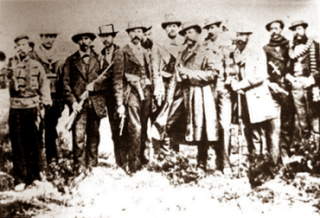 W
WThe Battle of Calama or Battle of Topáter was fought on March 23, 1879 between Chile and Bolivia, and was the first battle of the War of the Pacific.
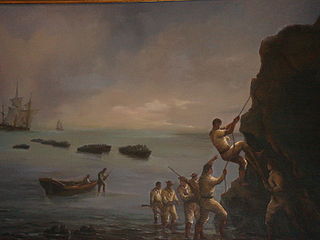 W
WThe Capture of Valdivia was a battle in the Chilean War of Independence between Spanish forces commanded by Colonel Manuel Montoya and the Chilean forces under the command of Lord Cochrane, held on 3 and 4 February 1820.
 W
WThe Bombardment of Valparaíso on 31 March 1866 took place during the Chincha Islands War, when a Spanish fleet shelled, burned and destroyed the undefended port of Valparaíso.
 W
WThe Battle of Yungay was the final battle of the War of the Confederation, fought on January 20, 1839, near Yungay, Peru. The United Restorer Army, led by General Manuel Bulnes, consisting mainly of Chileans and 600 North Peruvian dissidents, attacked the Peru-Bolivian Confederation forces led by Andrés de Santa Cruz in northern Peru, 200 kilometers (120 mi) north of Lima.